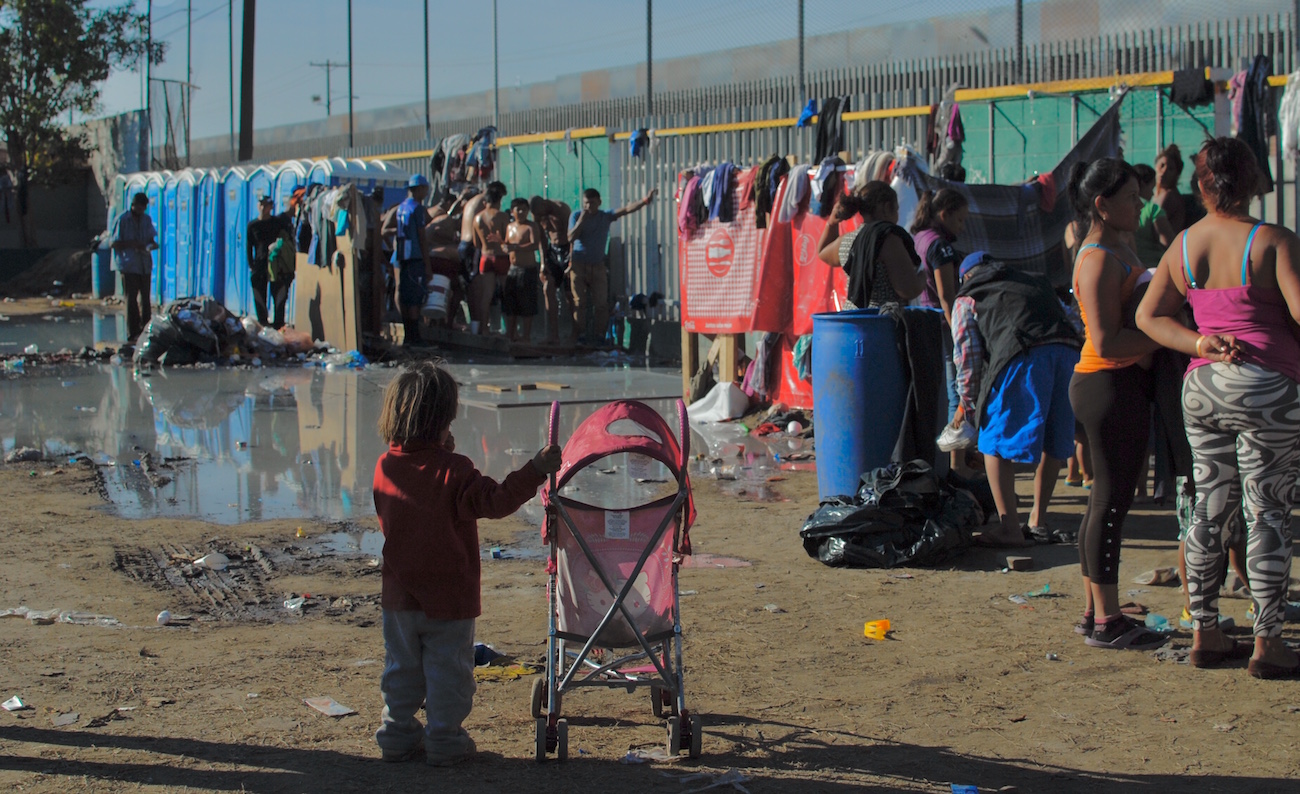[dropcap size=big]T[/dropcap]he public gym in Tijuana where thousands of migrants from Central America are sheltering with hopes of entering the United States is a squalid mess.
Along pathways, basketball courts, a baseball diamond, and even in landscaped planters, camping tents are crammed into any available space. Each holds a handful of men, women, or children who have traveled more than 2,700 miles to reach TJ, this dynamic yet perennially hardscrabble border town.
The migrants, and the exhausted volunteers who are helping them, have fashioned more shelters with used tarps and blankets. Coils of rope crisscross the air at eye-level in all directions. Migrants rest and sleep upon blankets, plastic sheets, cardboard, or on the dusty ground and concrete.
A row of portable toilets, some with doors broken or missing, is surrounded by shallow pools of foul-smelling mud. Nearby, migrant men and boys in nothing but underpants cling together under open-air showers, just a few feet away from screaming traffic on Via Internacional, a road that runs parallel to the US-Mexico line.
And the camp is growing, clearly overwhelming local authorities, who move about with almost shell-shocked expressions behind medical face masks. Disease is spreading, local news reports said, including lice and respiratory infections. Four migrants in Tijuana have tested positive for HIV, and four have chicken pox, the local health secretary said. Thirty-four women are pregnant.
This is the Deportivo Benito Juarez in Tijuana’s Zona Norte, and there’s no shaking the sensation that the scene inside is shocking and distressing. It looks like it could be a refugee camp in Iraq or somewhere in the Middle East, or like the squalor found amid the semi-permanent homeless encampments in urban Los Angeles.
The tents spill beyond the gym’s gates to Calle 5 de Mayo outside. Some migrants or locals have taken to selling cigarettes or slices of pizza from a pizzeria box, 20 pesos each. In the mornings and evenings, Mexican Naval troops head a feeding-kitchen. On Tuesday morning, migrants stood in rows to collect a foam bowl filled with a few spoonfuls of rice and an orangey stew, along with a cup of hot chocolate.
'We are here for a dream.'
Along the path, various organizations and government bodies have set up booths to aid the migrants: medical, legal, human-rights. The inevitable Christian evangelizers and hard-left activists weave among the crowds, yearning for converts. Too many reporters and camera crews all hunt for what is essentially the same story: weepy tales of a migrant’s vulnerability and desperation.
Overall, the people here are incredibly composed, cooperative, and grateful. “They’ve treated us well,” said Fernando Villanueva, 21, as he stood in line for his plate of breakfast. “We have food, medical attention.”
RELATED: Mexico Will Deport 98 People to Honduras Following Border-Rushing Melee in Tijuana
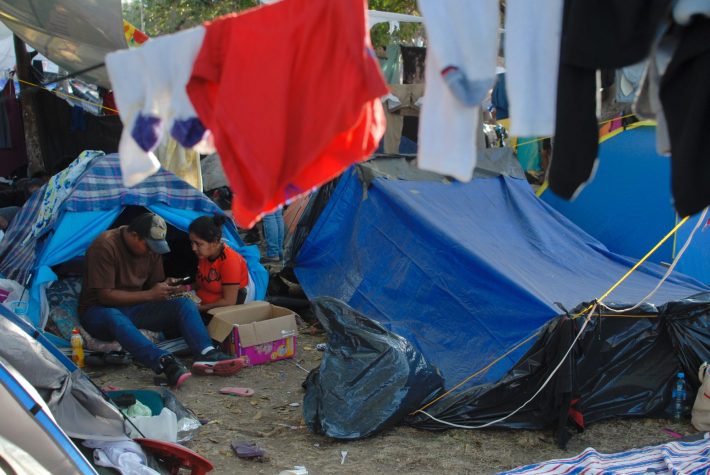
The so-called migrant caravan itself has dissipated, transforming from a cohesive boogeyman — employed by President Donald Trump for political points during the midterm elections — into a rolling stream of people who keep arriving, day after day. Villanueva, for example, didn’t arrive with the caravan some 10 days ago, but just on Monday night.
After Sunday’s chaotic protest and tear-gassing by US border agents, hundreds more have decided to call it quits and return south. Mexico’s national immigration institute was fielding planes and buses to ferry migrants home, reports said. Even so, throughout the morning, word spread that a few thousand more were were not far behind, pressing north. Some said two thousand more, some said eight, some said fifteen.
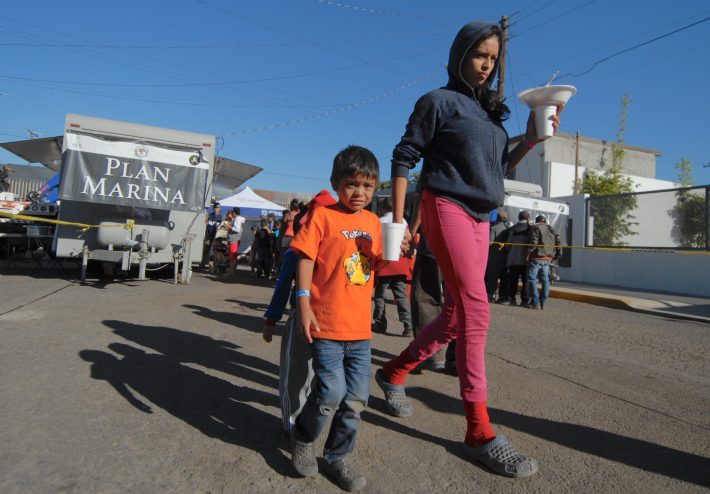
[dropcap size=big]T[/dropcap]hese figures should surprise no one. Central Americans and Mexicans from southern states have for decades sought passage north to the border with the United States, any which way they can. Remember La Bestia?
The current situation in Tijuana is merely the latest flashpoint in an ongoing humanitarian and migration crisis that — far from the halls of Washington or the manicured neighborhoods of L.A. — envelops North America. Our country’s foreign policy shoulders much of the blame: interventionist policies, from the civil wars of the 1980s to the more recent US-backed coup in Honduras in 2009, lead to endemic levels of poverty, violence, and corruption.
Just last week, a brother of the current Honduran president, Juan Orlando Hernandez, was arrested in Miami on drug-trafficking charges. The US-backed, conservative Hernandez is himself governing under a haze of illegitimacy. His re-election bid last year looked undeniably fraudulent, especially after the count was abruptly stalled when signals showed he wouldn’t win.
Understandably, migrants say they have no choice but to run.
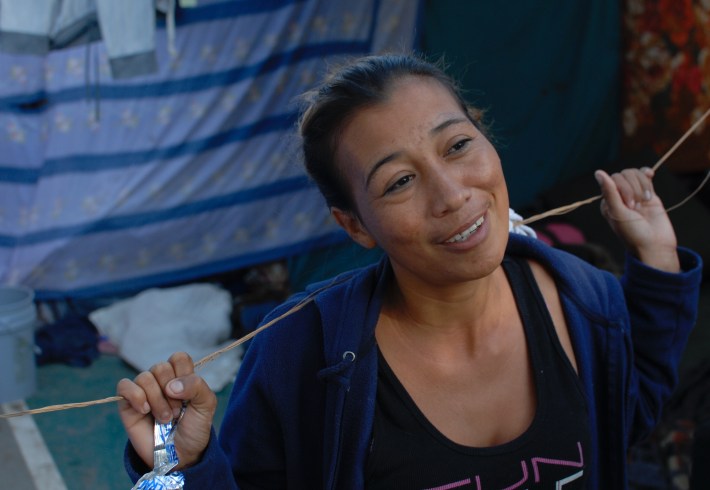
[dropcap size=big]S[/dropcap]ix weeks ago, Ana Lizeth Velasquez heard “through social media” in her town of Santa Cruz de Yojoa, Honduras, that a caravan was taking off for the United States.
At 36 years old, a single mother with a 16-year-old daughter, Velasquez earned whatever money she could making tortillas, but it was never enough. She said it is practically impossible for a woman over 30 to find work in her country. And she said the situation has grown worse under President Hernandez.
So, on October 13, she and her daughter Johana joined the caravan, in San Pedro Sula, known as one of the world's deadliest cities. On Tuesday, Velasquez stood amid a web of rope lines, describing her journey. And despite it all, she couldn’t help but smile. She said she is bolstered by faith.
“It’s been beautiful, one of the most beautiful things I’ve experienced,” she told me. “Guatemala was great, Mexico has been great. Anyone who says they’ve suffered is lying, maybe we’ve suffered with all the walking, but in general, it’s been good.”
I mentioned that Trump has said that 'bad people' are mixed into the caravan. “It could be,” she answered. “In every country, not everyone is a good person. But most of us are coming to work, and to provide for our families, for our children … We are here for a dream.”
RELATED: An L.A. Portrait ~ A Single Rent Increase Put This Woman on the Streets
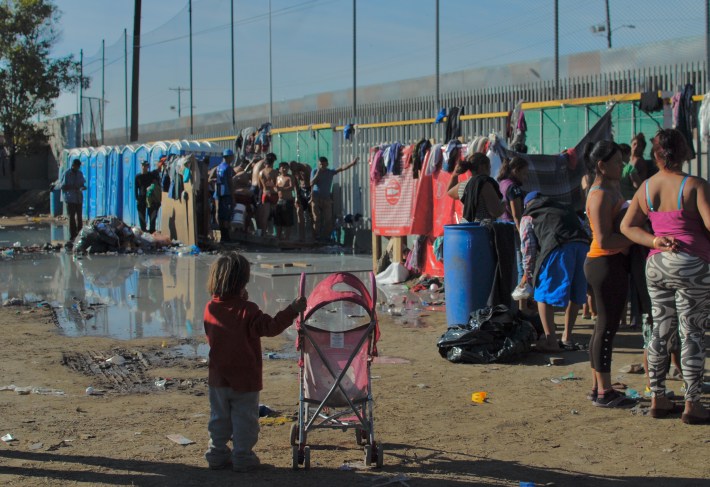
In the meantime, Velasquez is waiting. “I walk with faith in God,” she went on. “I am not afraid.”
In the weather forecast, rain is expected in the Tijuana area on Thursday, a worsening factor for an already alarming crisis. Most of the sheltering structures seen here would not survive a downpour.
Money and resources are petering out, Tijuana's mayor warned. Volunteers and municipal officials at the deportivo told me more tents and tarps are needed, as well winter clothing for the nighttime temperatures, shoes for children, blankets, toilet paper, prepared food, diapers, and personal hygiene products.
ALSO BY THE AUTHOR:
An Ashen Landscape in Malibu After Woolsey Fire Rips Through Canyons
These Oaxacan Muralists Brought Indigenous Flavor to the Central Library; Now They Are Deported
